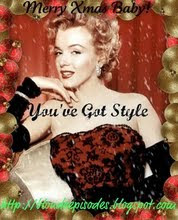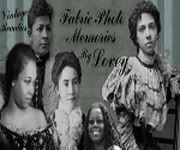Once
there was a man who wore the finest silks in Italy, but traded them all
for sackcloth. His father was a wealthy cloth merchant, and in his youth
he gamboled about Umbria in colorful, dandyish outfits. But when he had
his calling he stripped off his fine clothes, pledged his body to God,
and spent the rest of his life in a mendicant’s robe. He was Saint Francis of Assisi,
and when the archbishop of Buenos Aires was proclaimed pope in 2013, he
gave himself a new name, in honor of a man unembroidered.
I wonder what both Francises, saint and pontiff, might make of “Heavenly Bodies,” the Metropolitan Museum of Art’s colossal, hotly debated
and richly anointed exhibition on the interweaving of fashion and Roman
Catholicism. Years in the making, it includes exceptional loans of
vestments from the Vatican — some of which have never before left Rome —
and more than 150 ensembles of secular clothing from the last century.
Here is papal regalia of unsurpassed intricacy, but also space-age
brides, monastic couture, angels in gold lamé, and a choir up in the
balcony dressed in head-to-toe Balenciaga.

A 1967 wedding ensemble from the House of Balenciaga at the Met Cloisters.
For the
55 designers exhibited here, Catholicism is both a public spectacle and a
private conviction, in which beauty has the force of truth and faith is
experienced and articulated through the body. Sacrilegious? Heavens,
no: The show is deeply respectful of the world’s largest Christian
denomination, even reverential. But it takes communion at Fellini’s
church rather than Francis’s — a surreal congregation whose parishioners
express their devotion through enchanted excess.

An evening dress by Pierpaolo Piccioli for Valentino, 2017-18, at the Met Fifth Avenue.
“Heavenly
Bodies” is the largest exhibition ever offered by the Met’s Costume
Institute and was organized by its curator, Andrew Bolton. It runs from
its dedicated downstairs hall to the Byzantine and medieval galleries
and into the Lehman Wing; it then continues at the Cloisters, the
museum’s serene home for religious art in Upper Manhattan. Most of the
designers here were or are Catholics, including historical figures like
Elsa Schiaparelli, Cristóbal Balenciaga, Christian Lacroix and Yves
Saint Laurent, and active designers like Jean Paul Gaultier, John
Galliano, Raf Simons and Maria Grazia Chiuri.

The Italian-born Riccardo Tisci’s
statuary vestment for the Madonna delle Grazie, 2015. (Original design
was by the Poor Benedettine Cassinesi Nuns of Lecce in 1950.)
Catholic Europe dominates; the United States is represented by Thom Browne (Mr. Bolton’s partner)
and Kate and Laura Mulleavy of Rodarte; but designers from Latin
America, the pope’s old stamping ground, are dismayingly absent.

An evening ensemble by John Galliano for House of Dior, 2000-2001.
After Mr. Bolton’s rigorous left-brain exercises of the last two years — the excellent, tech-minded “Manus × Machina” in 2016 and the body-questioning retrospective of Rei Kawakubo last year — this show is a return, for better and worse, to the high spectacle of “China: Through the Looking Glass.”
It goes heavy on the Catholic drama, with mannequins posed as angels
and novitiates, and there’s music throughout. (Playing in the medieval
sculpture hall is an intolerable loop of staccato string accompaniment,
drawn from a film soundtrack by Michael Nyman, that will make you wish
the Costume Institute would take a Cistercian vow of silence.) It also
places the clothing amid the Met’s superb collection of Byzantine and
medieval art — ivories, tapestries, reliquaries. This intermarriage of
religious art and secular fashion feels refreshing in places, silly in
some; either way, it’s an event.
“Heavenly
Bodies” is, to use a formula Catholics will find familiar, both one
show and three. You can begin your approach to this trinity of fashion
with the showcase of holy vestments in the basement galleries, or you
can start upstairs with the grand secular displays inspired by Catholic
hierarchy and ceremony (the weakest third). Then conclude at the most
contemplative, and strongest, third — the gowns evoking orders and
sacraments at the Cloisters.

An installation view of the Met’s
medieval and Byzantine art wing, including a red silk taffeta dress
by
Pierpaolo Piccioli for Valentino and John Galliano’s evening ensemble
for House of Dior.
The
exhibition’s presentation of secular clothing begins on either side of
the Met’s central staircase, in the hallways devoted to Byzantine art.
Five evening dresses from a recent collection of Dolce & Gabbana
feature hand-sewn paillettes that cohere into icons of Mary and the
saints, based on the mosaics of a Sicilian church. More inspired are
Gianni Versace’s diaphanous dresses of gold and silver mesh, a signature
material that the designer garlanded with crosses. He presented them
for fall 1997: a season he never saw, as he was murdered that summer in
Miami.

An evening ensemble, from 2000-1, for the House of Dior by John Galliano.
Versace drew inspiration from the Met’s 1997 blockbuster, “The Glory of Byzantium,” and these clingy sheaths set the stage for an encounter between religious art and clothes for the (rich and thin) laity.

Christian Lacroix wedding ensemble, 2009-10.
In a gallery shaped like a Byzantine apse stands a Gothic haute couture
gown by Jean Paul Gaultier — technically stunning but too gaudy to love —
that incorporates holographic images of saints and aluminum panels
decorated with eyes or hearts, like the ex-votos believers place in
shrines. A mask of leather straps and cruciform plastic beads by the
Belgian duo A.F. Vandevorst offers a rare dose of fetishism, though it
is not half as fierce as the Met’s rosary from 16th-century Germany in
the same case, composed of ivory beads half-face, half-skull.

An evening dress of black silk cloqué and light blue silk taffeta from Eisa and Balenciaga, 1949.

House of Givenchy, Alexander McQueen evening ensemble, 1999.

A choir of mannequins dressed in choral robes from the 1990s by Cristóbal Balenciaga. Original design, 1964

A detail of Giovanna Fontana “Il Pretino” dress, 1956-57.

Christian Lacroix “Gold-Gotha” ensemble and reliquary cross, 1988-89.

Thom Browne, ensemble, 2011-12, with black mink and white Persian lamb at the Met.
Up here the show's designers, the architects Diller Scofidio + Renfro, have opted for a consciously operatic display. Spotlights
fall on a low-cut gown of red silk, designed by Pierpaolo Piccioli for
Valentino this year, flashing more skin than any cardinal would allow.
The hall’s Spanish iron choir screen frames an eye-popping haute couture
ensemble by John Galliano for Dior in 2000-1, with a beaded headpiece
shaped like a bishop’s mitre. The back is embroidered with a crucifix
and the inscription “Dieu est mon maître”: God is my master. (A male
model wore this gown in Mr. Galliano’s presentation, though it was
designed for clients of either gender.)
Yet
those who feared that this exhibition might edge into blasphemy will be
relieved to hear that it takes few liberties. Quite the contrary: Mr.
Bolton, a Catholic, treats the faith so earnestly that he re-sacralizes
the medieval art on display. His approach to the “Catholic imagination”
treats the visual splendor of the church as more than just a poor man’s
bible, but as a manifestation of God that inheres in all beauty,
including fashion. Holy vestments serve in the transubstantiation of
wine and bread into blood and body, and in a similar way these secular
garments also turn the Met’s medieval collection back into objects of
worship.
Anyway, if these designers
are sometimes rule breakers, they are not apostates. In fact two gowns
here, one by Saint Laurent and the other by Riccardo Tisci, are not for
humans at all; they were designed as costumes for statues of the
Madonna.

Yves Saint Laurent wedding ensemble, 1977-78, made of materials including ivory silk crepe, Chantilly lace and organza.

A detail of Riccardo Tisci’s statuary
vestment for the Madonna delle Grazie, 2015.
(Original design by the
Poor Benedettine Cassinesi Nuns of Lecce in 1950.)
This
decision to mimic, rather than analyze, the splendors of the church is
highly uncommon for a museum, and bracing in places. One can see why
Cardinal Dolan and other ecclesiastical figures have been pleased. The
downside is that “Heavenly Bodies” pushes so hard on the senses here
that you are forced to leave your art historical tools in the nave. How
were these ensembles made? Whom did they influence? Those are questions
for tomorrow; for now, let us pray to saints Cristóbal, Jean Paul and
Raf.
Such a carnal approach to
Catholicism also comes at the cost of critical engagement with the
ironies of fashion — above all, with ironies of gender. It seems, almost
always, that the transference of the “Catholic imagination” from sacred
clothing to secular has to pass through a woman’s body. There is almost
no men’s wear in this exhibition; one rare entry is a wool coat by Mr.
Simons, inspired by a priest’s soutane. The angels clad in Lanvin and
Rodarte inhabiting the final gallery are all women, too. This display
may merit a thousand praying-hands emoji on Instagram this summer, but
you might ask whether these designers have merely perpetuated the gender
discordance of the church in a more colorful key.
Downstairs
Apostolic Elegance

The diplomatic and liturgical coup of
“Heavenly Bodies” is the loan of Vatican
objects: “The Keys of Saint
Peter (Keys of Heaven)” given to Leo XIII,
left, the zimarra and fascia,
the zucchetto and shoes of John Paul II (1978-2005)
in the Vatican
section of the Met exhibition.

Mitre of Leo XIII (1878–1903). German
cloth of silver embroidered with gold metal thread,
diamonds, emeralds,
sapphires and semiprecious stones, from 1887.

Tiara of Pius IX (1846-78), German
and Spanish, 1854.
Cloth of silver embroidered with gold metal thread,
gold, diamonds, rubies, sapphires, emeralds and pearls.
The diplomatic and liturgical coup of
“Heavenly Bodies” is in the Anna Wintour Costume Center, which features
nearly four dozen articles of clothing and other regalia of recent
popes, lent from the Sistine Chapel Sacristy. The church obliged the Met
to keep the religious garments separate from the fashion objects, and
they wanted a clean display, as the vestments are still in use. Diller
Scofidio + Renfro delivered with a design of extreme restraint.
Chasubles, mantles and tiaras appear in pristine cases, and entire walls
are left white.
A glorious cope, or
outer cloak, painstakingly made between 1845 and 1861 and worn by Pius
IX, is laid flat like a grand, wearable semicircular tapestry; in its
central gold shield is a dynamic nativity scene in embroidered silks of
blue, pink and melon. A vision of Adam and Eve’s expulsion sits beneath.
Pius
IX seems to have been a bit of a clothes hound, and of the many
accessories in a smaller gallery — mitres, crosiers, rings, and a
pectoral cross of gold and amethysts that would suit Cher — the most
opulent are Pius’s three tiaras, festooned with rubies and sapphires. A
German-made tiara here is ringed by three crowns comprising 19,000
stones, mostly diamonds.
These are awe-inspiring, though you need not be Martin Luther to look askance at their opulence. In the show’s catalog, Cardinal Gianfranco Ravasi
writes that while “beauty and art have been the inseparable sisters of
faith and Christian liturgy for centuries,” Catholics ought to recall
Jesus’s warning, in the Woes of the Pharisees, not to make a show of
your dress. No pope has worn a tiara since the Vatican II reforms of the
1960s — unless you count Jude Law as the chain-smoking, archconservative “Young Pope,” who sported one for his terrifying investiture speech.
The Cloisters
Monastic Solitude

John Galliano for Dior. Rubber-coated linen twill at the Met Cloisters.

Viktor & Rolf ensemble, 1999-2000, at the Cloisters.

Jean Paul Gaultier’s “Guadalupe” evening ensemble (2007), at the Cloisters.

Thom Browne wedding ensemble, 2018, with gold bullion, pearls,
crystals and white mink, at the Met Cloisters.

Dolce & Gabbana, wedding dress, 2013, made of gold silk
and metal macramé lace, crystals and silk tulle with gold Lurex.
Where
the clothing at Fifth Avenue draws on Catholicism’s rigid hierarchy and
public rites, the Cloisters showcases fashion reflecting the quieter
side of faith. It’s here you’ll find, in the reconstructed Spanish
chapel, the show’s most famous ensemble: Balenciaga’s 1967 wedding gown,
made of silk the color of ice milk and topped with an architectonic
hood in place of a veil. (The photograph at the top of the article)
Erroneously known as the “one-seam wedding
dress,” this extraordinary garment appears to have been immaculately
conceived rather than sewn. Here, too, the scenography is hardly subtle;
the Balenciaga bride faces the apse as if in prayer, and speakers
twitter “Ave Maria.”
But in general
Mr. Bolton’s choreographed rendezvous between contemporary clothing and
holy art of the past are more rewarding in the Cloisters’ tight
confines, where one-to-one encounters come more easily. Precisely arced
straw hats by the experimental milliner Philip Treacy appear as a
mathematician’s response to the wimples of “The Flying Nun,” and sit in
front of Netherlandish reliquary busts of female saints. A long black
dress from 1999 by Olivier Theyskens, its bodice incised with a
cruciform gap, stands between painted limestone statues of Saints
Margaret and Petronilla. Near the garden is an extraordinary couture
dress by Ms. Chiuri and Mr. Piccioli for Valentino; its metal-thread
embroidery translates Cranach’s Adam and Eve, and its flora and fauna,
into splendiferous ornament.
Mr.
Bolton has made the unexpected and rewarding decision to place more than
a dozen ensembles outdoors, in colonnades that ring the central
cloister. Most outfits draw on monastic dress, including Mr. Piccioli’s
elegant hooded dress of brown cashmere and Mr. Owens’ notorious (and
rather stupid) sportswear robes cut out at the crotch. And there are
older pieces, including an evening dress made in 1969 by the French
designer known as Madame Grès, whose beige pleats are cinched by a brown
knotted belt. Its inspiration is unmistakable: the habit of Zurbarán’s
painting of St. Francis of Assisi, the rough brown cloth evoked through
Madame Grès’s pilling angora wool.
His namesake gave a speech this September
that is worth keeping in mind when you see “Heavenly Bodies,” in which
he insisted that what is holy resides not in beauty alone. “I ask for
the Church and for you the grace to find the Lord Jesus in the hungry
brother, the thirsty, the stranger,” Pope Francis pleaded. And to find
it, too, in “the one stripped of clothing and dignity.”

Maria Grazia Chiuri and Pierpaolo
Piccioli’s evening assemble for
Valentino, 2015-16, in a Romanesque
chapel at the Met Cloisters.
All fashion photography: Vincent Tullo, New York Times
“Heavenly Bodies: Fashion and the Catholic Imagination”
Through Oct. 8
at the Metropolitan Museum of Art and the Cloisters
212-535-7710 metmuseum.org.
Now, go make something beautiful!
¸.•´
¸.•*´¨) ¸.•*´¨)(¸.•´
(¸.•´♥ Tristan ♥
(¸.•´♥ Tristan ♥
Highlights from the 2018 Met Gala opening
of the "Heavenly Bodies" exhibition
















and my personal favorite, complete with a
nativity scene headdress, if you should run into Sarah
Jessica Parker at the Met Gala Ball, you only have one
option: bow.





















































































4 comments:
I don't know where to begin, your post is fascinating and I thank you for your detailed remarks on the exhibit. I wish I could see it, but you brought me as close as possible! Being a Catholic girl who went to Catholic schools I am familiar with the opulent Mass robes. I was always fascinated by the Nun's dress and head coverings, aka the flying nun!
Thank you so much for my tour of the met!!
Wonderful to read! Thank you for putting this together!
Wow. What a comprehensive post/review -- so well written, photographed and in such terrific detail. I am in awe.
It also reminds me that I haven't been to the Cloisters in more than 40 years (yikes!) and what a remarkable museum that is. I should think this exhibit would be fabulous there.
Definitely a four-star post, Tristan!
WOW Tristan! I had to make a second pot of coffee while reading this post! heehee
I too went to Catholic school and am reminded of the robes and such,one priest was gifted a ruby adorned gold chalice by a family that adored him! The priests unlike the nuns did not take the vows of poverty! WTF!
Anyway, if I get the chance, I would LOVE to go see this, what a display it is- thank you so much for sharing everything you have put together for this- remarkable post! Well done!
Jackie xx
Post a Comment